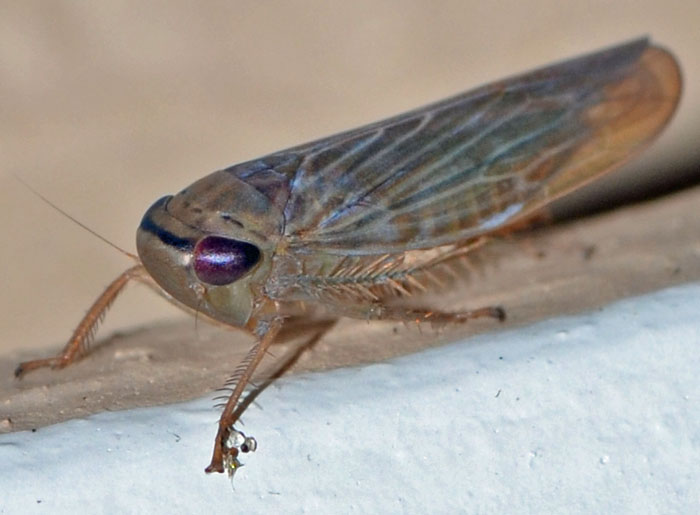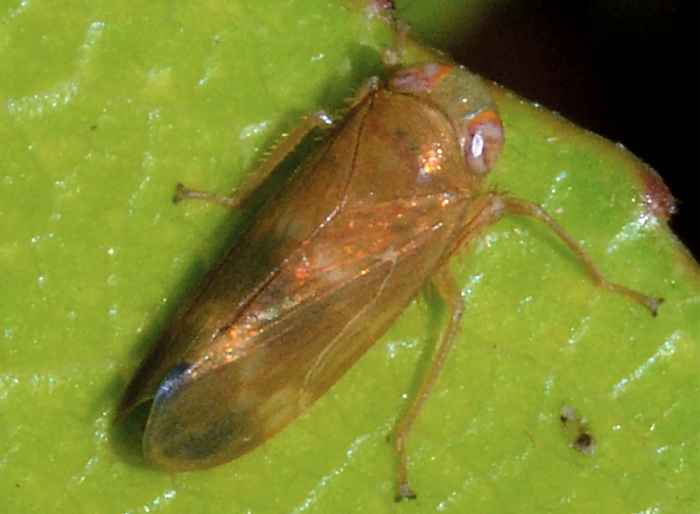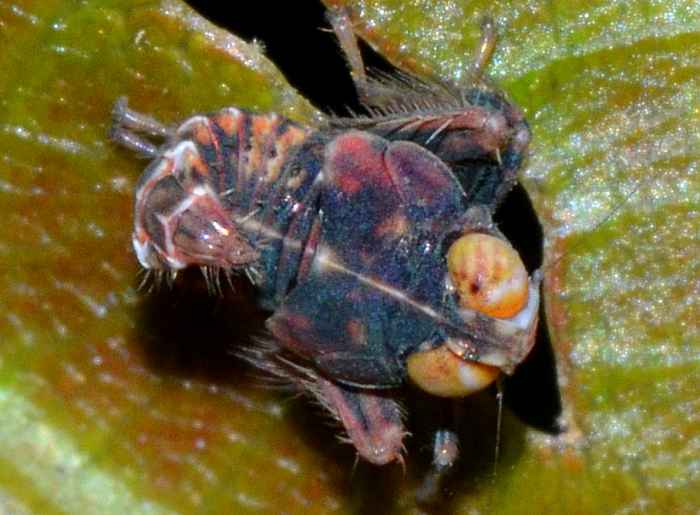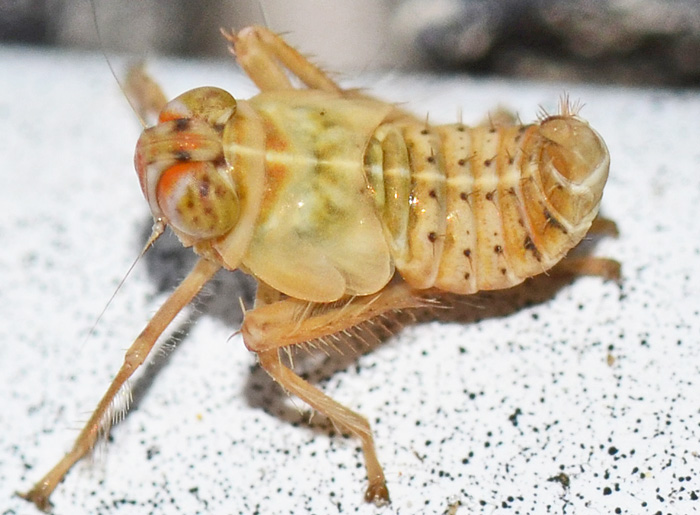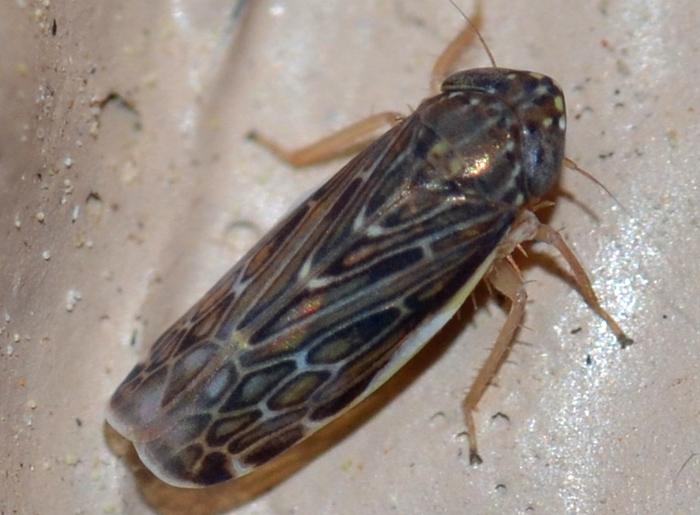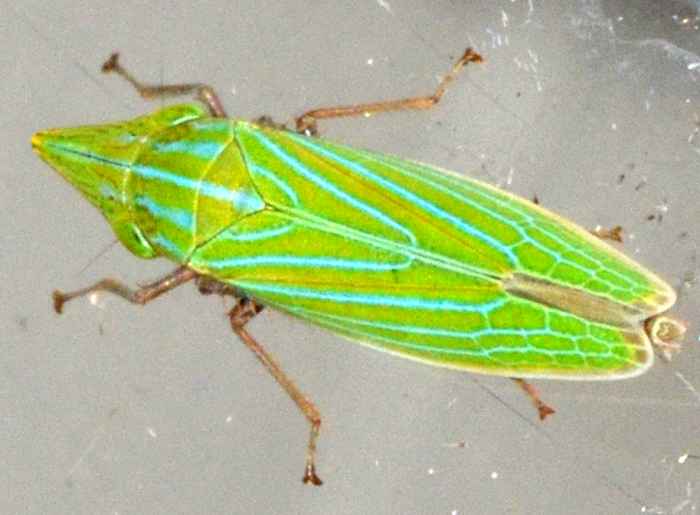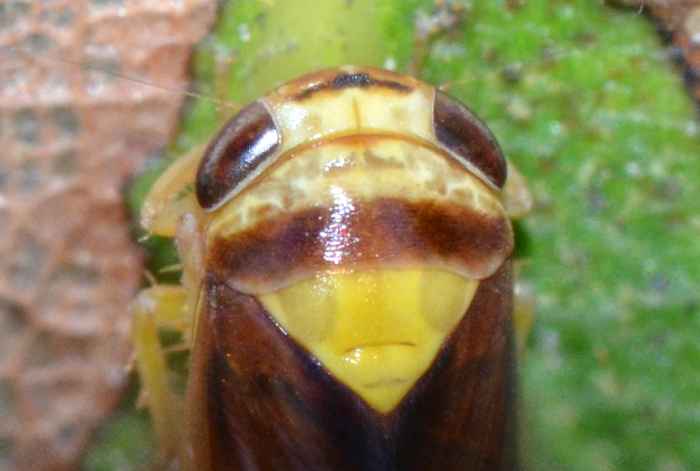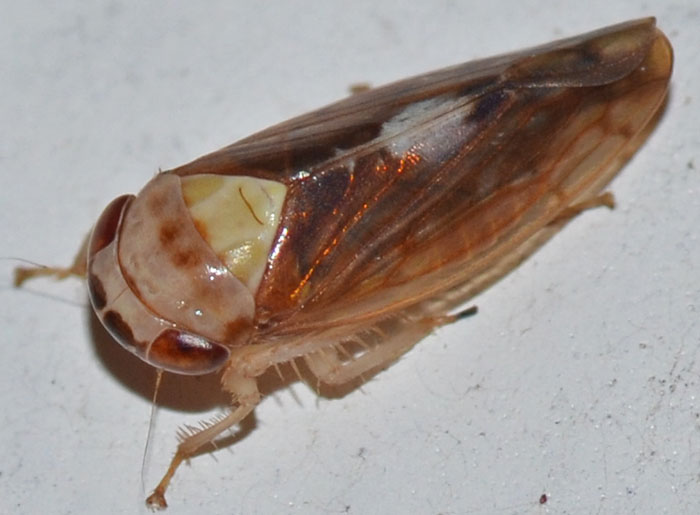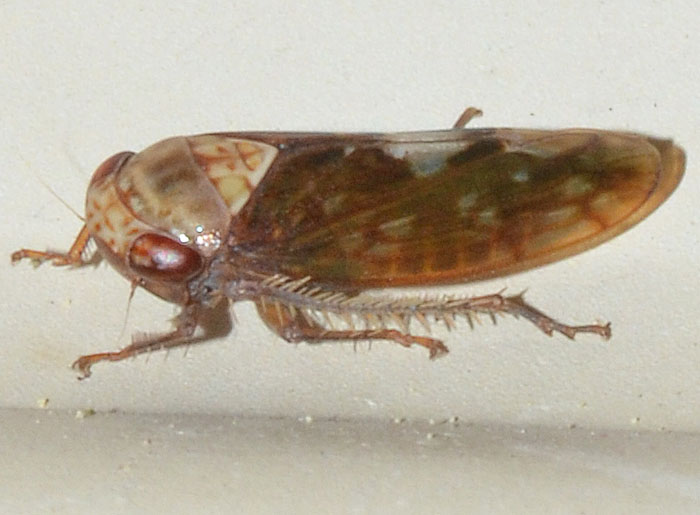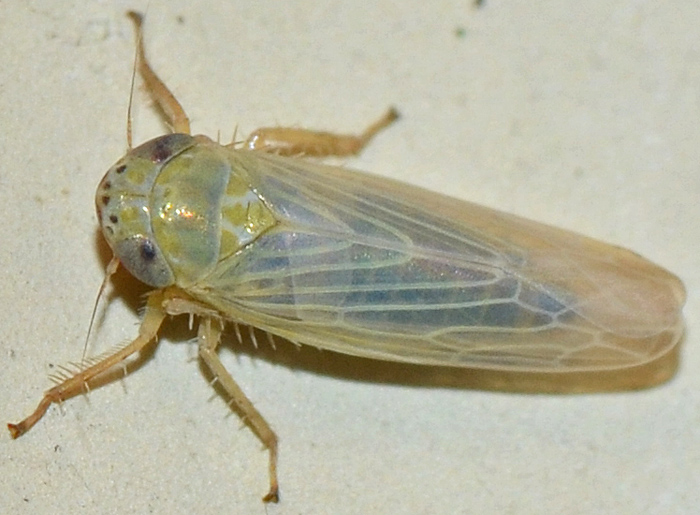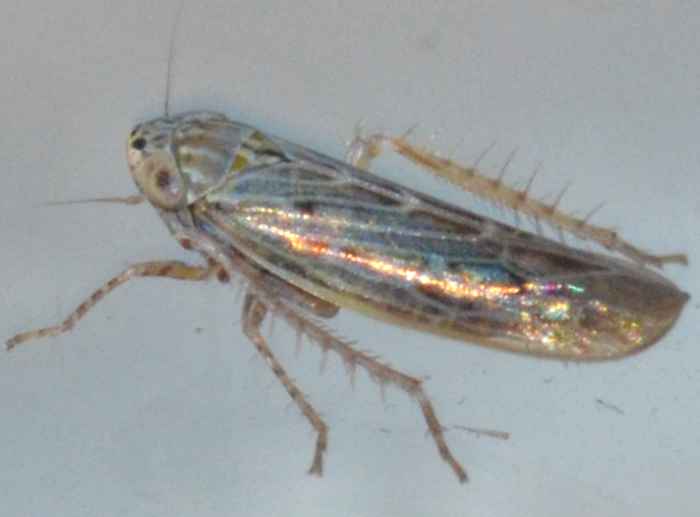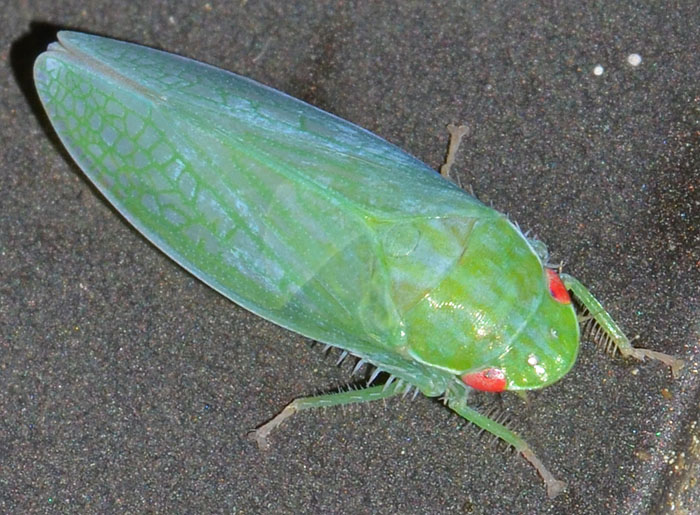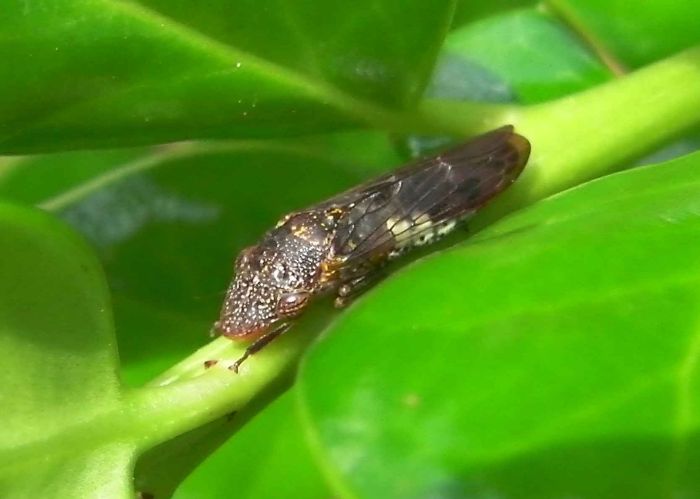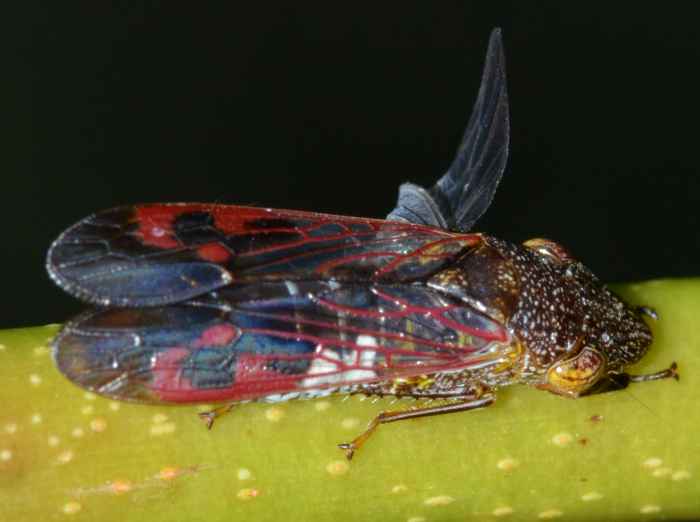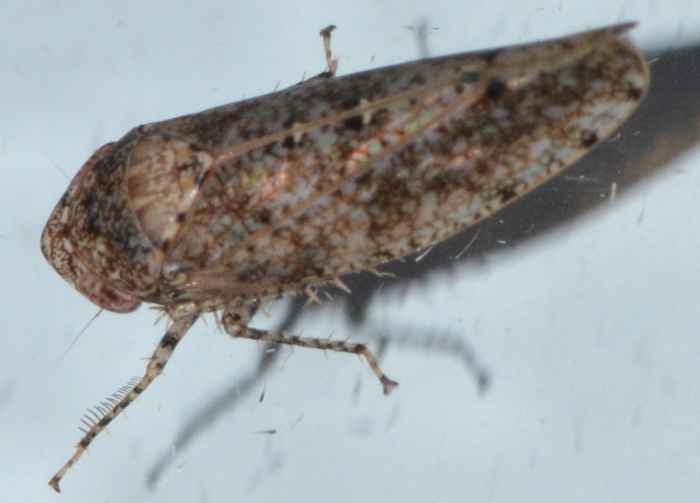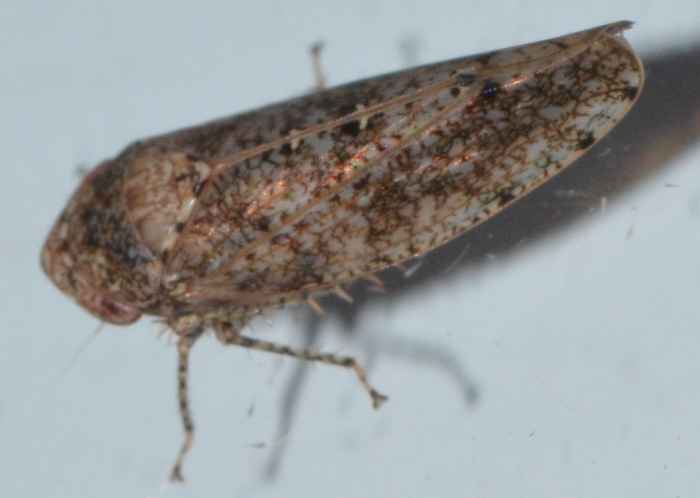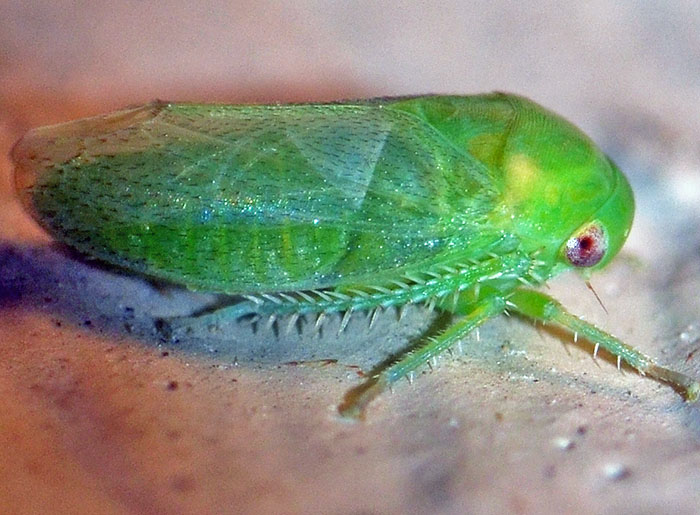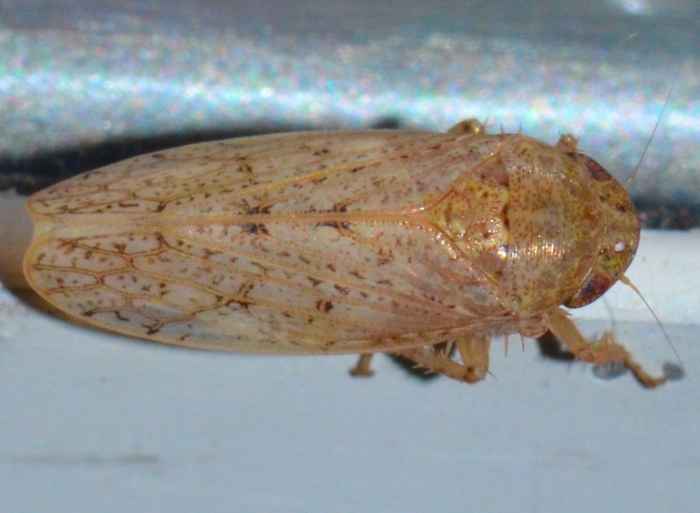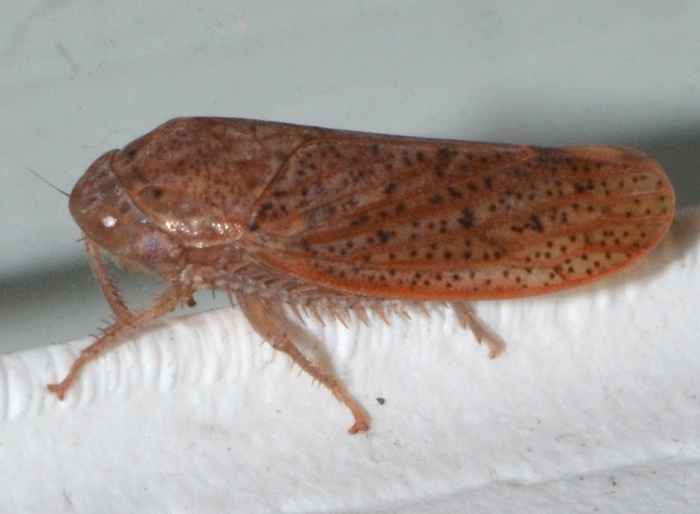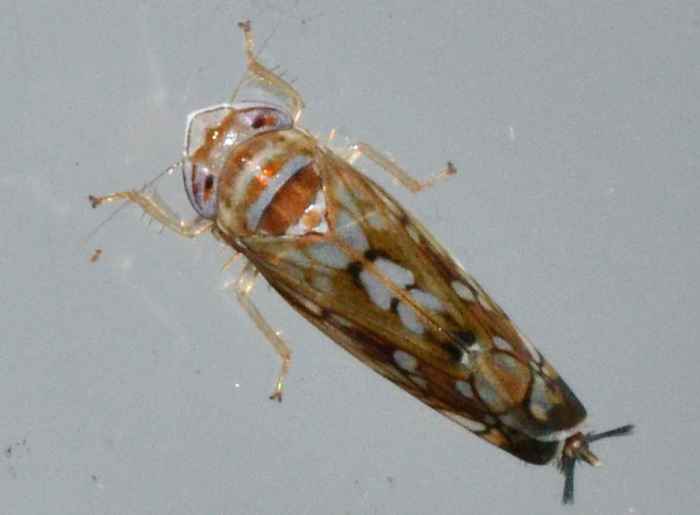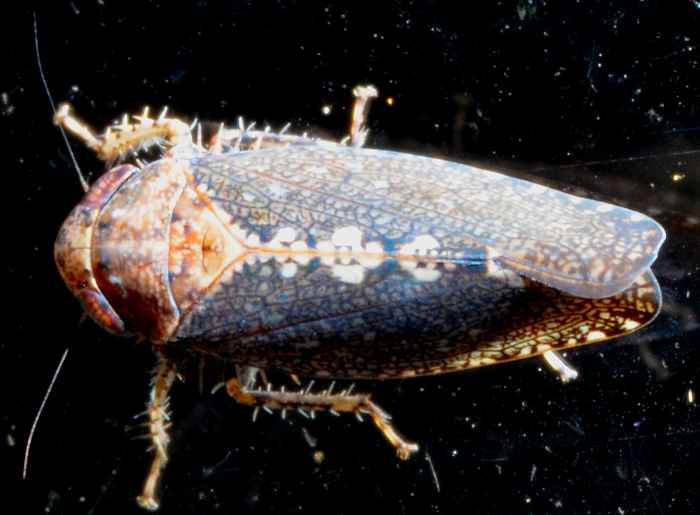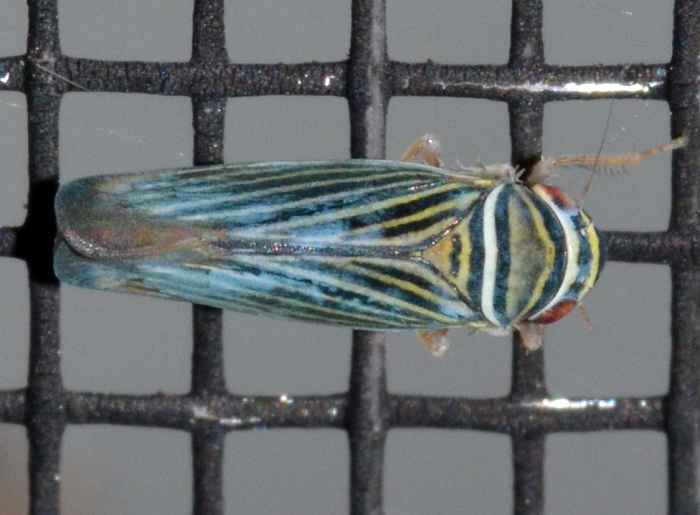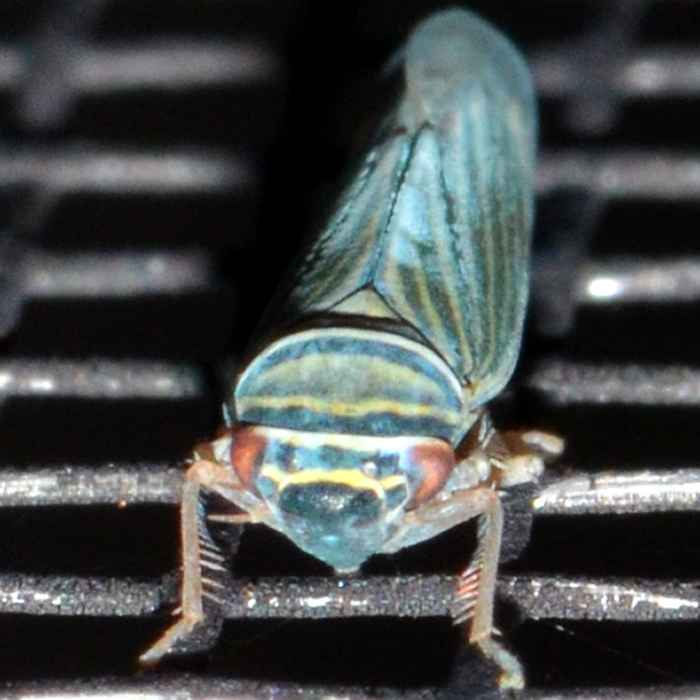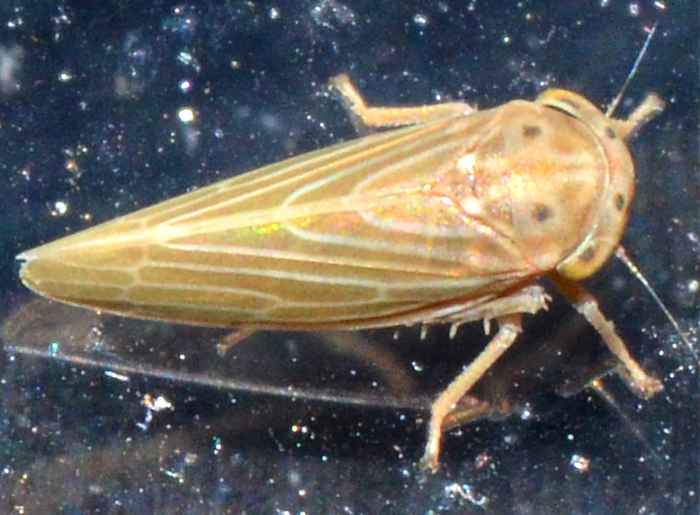 Agallia constricta. | Agallia constricta is one of 14 North American species in this genus. The nymphs in this genus have characteristic ear-like nodules between their eyes. A very similar species is A. quadripunctata which has wider wings than A. constricta. The number of dark spots seems to be a less important feature.
bug guide (this photo): http://bugguide.net/node/view/648624 | ||
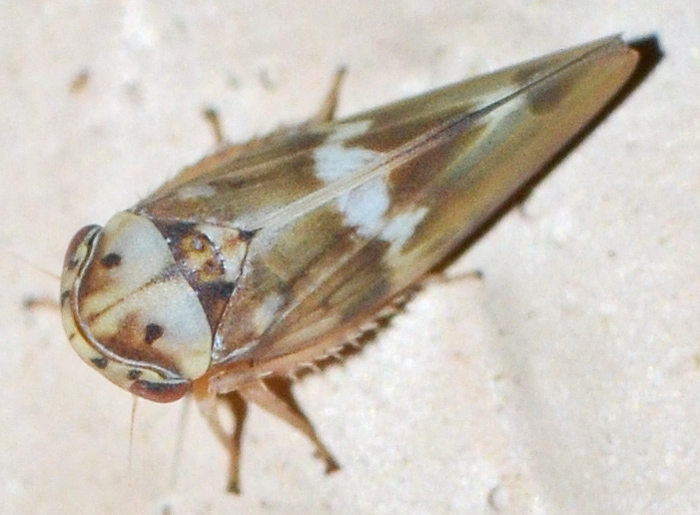 Agalliopsis cervina. | The second link describes a sister species: "Shaw (...) studied the sound production of an Agalliopsis species, A. novella. The male begins by emitting 'common sounds' which are unique to the species. If receptive, the female responds with the common sounds. The two then alternate producing these sounds, and eventually the male moves alongside the female.
At the side of the female, the male soon attempts copulation 'by leaping onto her back.' But just before making this leap, the male emits the precopulatory sound, 'a sequence of irregular buzz-like pulses' accompanied by a vibrating of his wings."
bug guide (this photo): http://bugguide.net/node/view/1263195 American Insects: http://www.americaninsects.net/h/agalliopsis-sp.html | ||
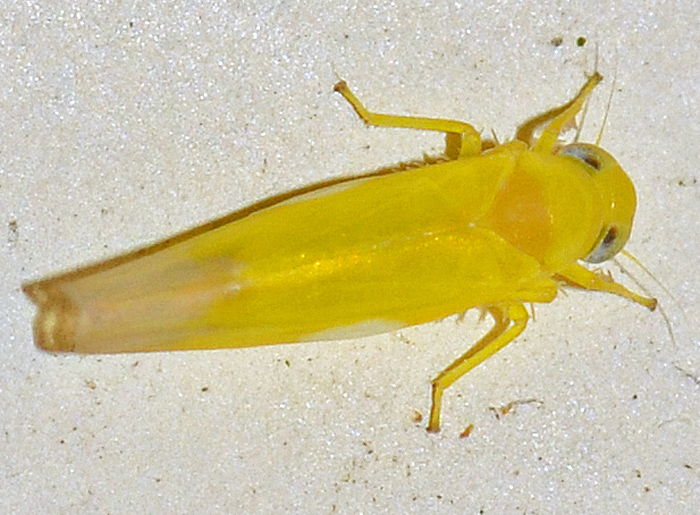 Alebra sp.. | The color of this little leafhopper is quite amazing. It is perhaps Alebra aurea which is one of the eleven US species in this genus. bug guide (this photo): https://bugguide.net/node/view/1224526 | ||
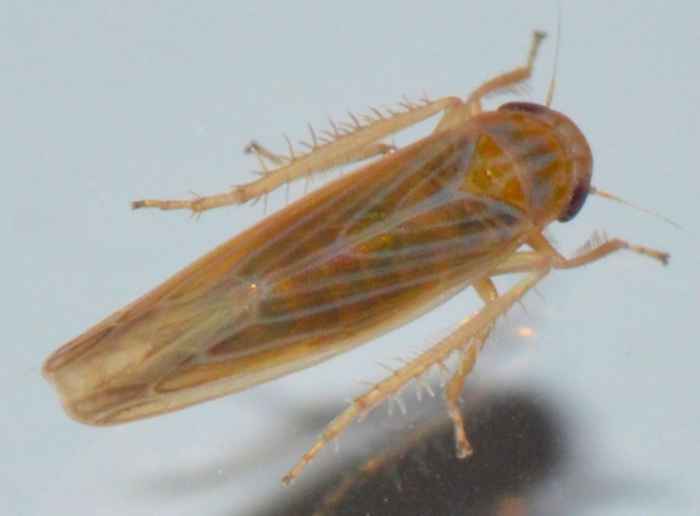 Balclutha sp. (Balclutha Leafhopper). | This tiny leafhopper is probably Balclutha neglecta but Dr. A. Hamilton (see link) pointed out that there are several similar species in Florida (16 in North America). They are common in lawns. This one came to the light of our living room window. bug guide (this photo): http://bugguide.net/node/view/576243 | ||
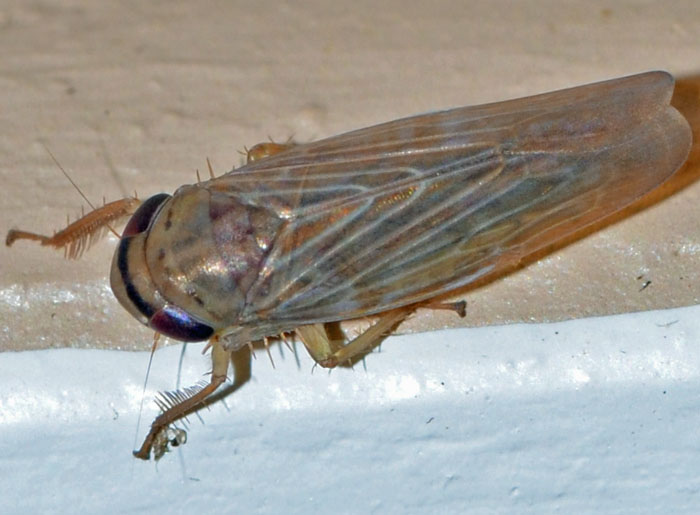 Chlorotettix necopinus. | Chlorotettix necopinus is the only brown member of the genus. It is similar to Athysanus argentarius, but is darker and narrower. I think that the brown band between the eyes makes this one cool looking leafhopper.
bug guide (these photos): http://bugguide.net/node/view/980584 | ||
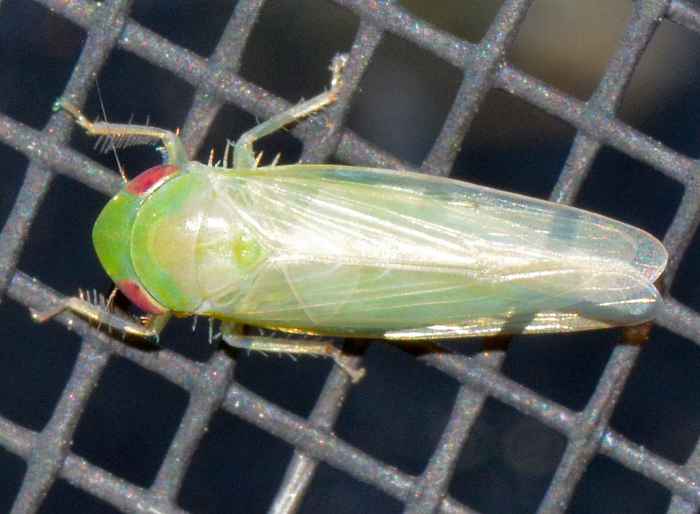 Chlorotettix sp.. | Chlorotettix sp. has at least five species in the US. An expert (see link) states that this genus is "(l)arger than Empoasca, with more definite wing veins". bug guide (this photo): http://bugguide.net/node/view/631062 | ||
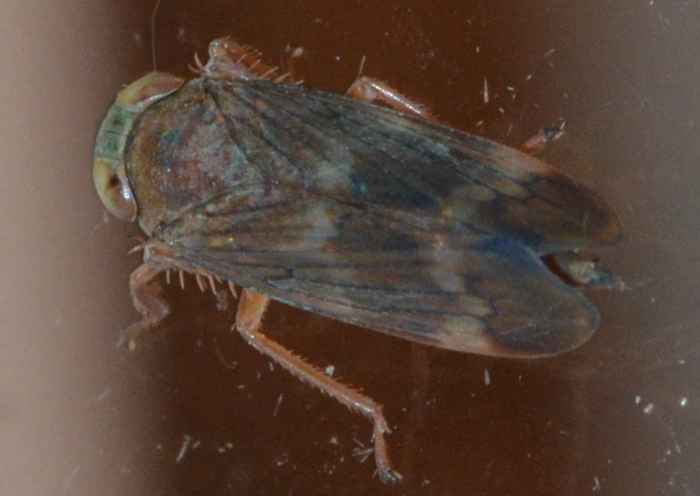 Coelidia olitoria. | A brownish, fairly large leafhopper that is common East of the Rocky Mountains. This is Coelidia olitoria. It also has awesome nymphs.
The small photo was taken on 05/28/12. Dr. Hamilton (see second link) states that this specimen could be "a hybrid between the typical subspecies and C. floridana".
bug guide: http://bugguide.net/node/view/7348 bug guide (small photo): http://bugguide.net/node/view/648230 | ||
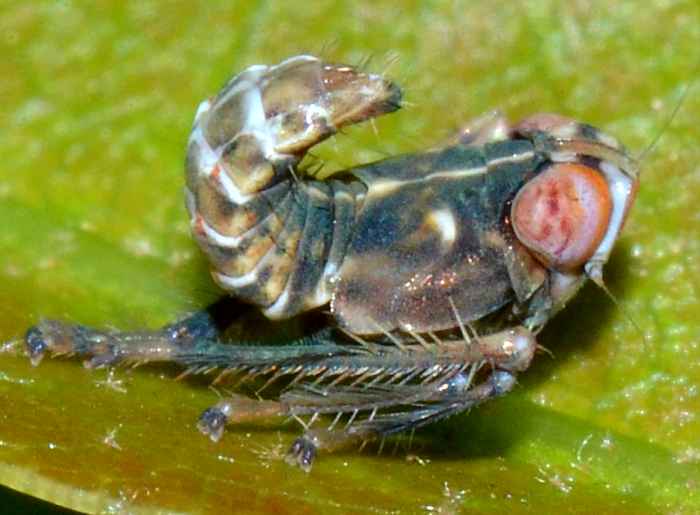 Coelidia olitoria - imm. | Okay and here are my first sightings of Coelidia olitoria nymphs. They can be light brown, grayish, bluish, red, sometimes yellow or brownish-yellow throughout. The nymphs are most unusual but unfortunately also a "big" challenge for my camera and photography skills. The small photo of the beige/orange nymph was taken on 05/15/16 around noon.
bug guide (large photo): http://bugguide.net/node/view/636531 bug guide (small photo): http://bugguide.net/node/view/1223851 | ||
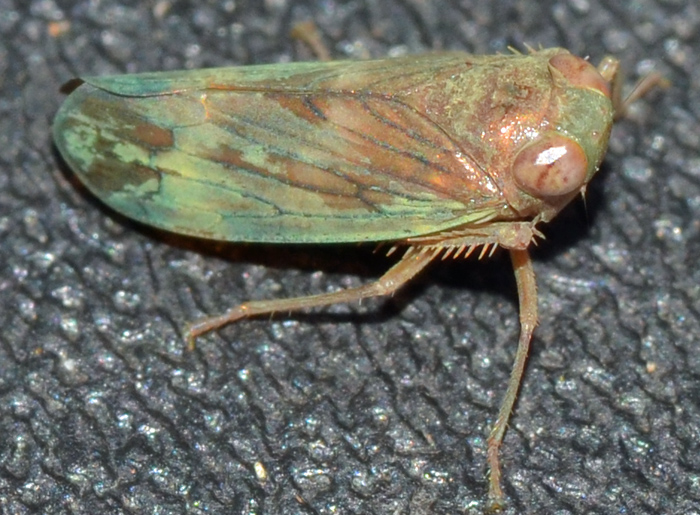 Coelidia floridana. | Until recently, Coelidia floridana has been considered a subspecies of C. olitoria. This reclassification became necessary after genetic analyses. bug guide (this photo): http://bugguide.net/node/view/940147 | ||
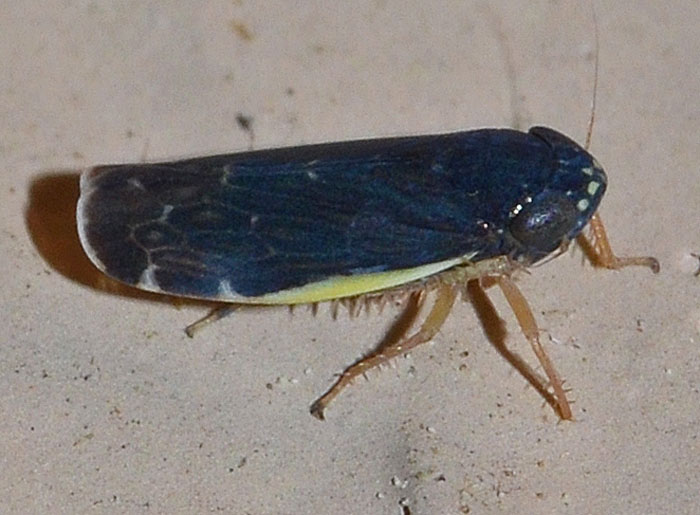 Deltocephalus flavicosta. | This rather dark leafhopper belongs to the subgenus Planicephalus and is most likely Deltocephalus flavicosta. The very similar sister species D. flavocostatus is found only in Tennessee and states north of Tennessee. The small photo shows a different specimen (05/17/16 at 10 pm).
bug guide (this photo): http://bugguide.net/node/view/1066938 | ||
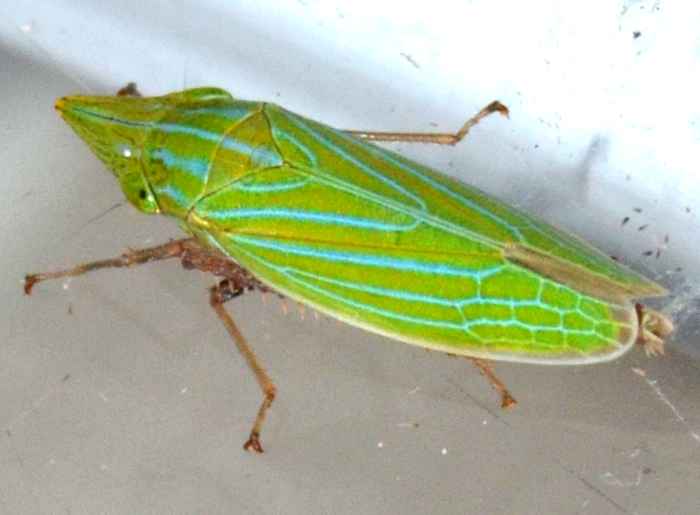 Draeculacephala producta . | Draeculacephala producta is the most long-headed member of the genus and occurs in the Southeast, Texas, and Cuba. The color contrast in these photos is too strong.
bug guide (these photos): http://bugguide.net/node/view/664305 | ||
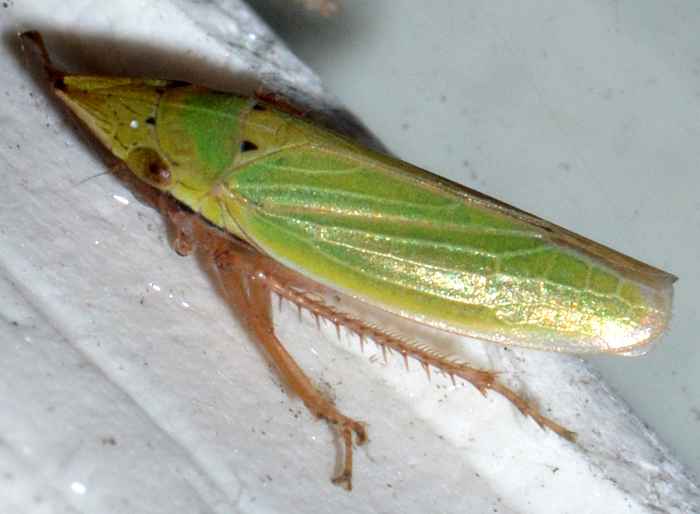 Draeculacephala balli. | Draeculacephala balli is a rather short species. It has two black spots on the head and on the triangular wing base (scutellum). Notice that the latter are also triangular pointing backwards.
bug guide (this photo): http://bugguide.net/node/view/664300 | ||
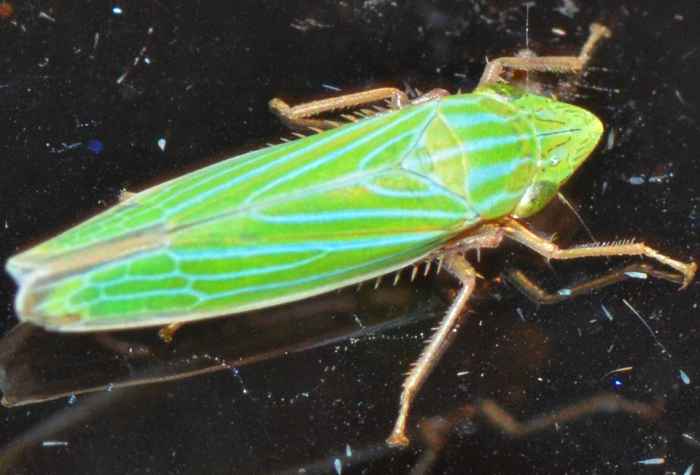 Draeculacephala mollipes. | This sharpshooter is Draeculacephala mollipes. The species in this genus have triangular, pointy heads and their veins are often bluish. They primarily feed on grass. There are 20 species in this genus in North America.
bug guide (this photo): http://bugguide.net/node/view/572861 Tom Murray: http://www.pbase.com/tmurray74/sharpshooters_draeculacephala | ||
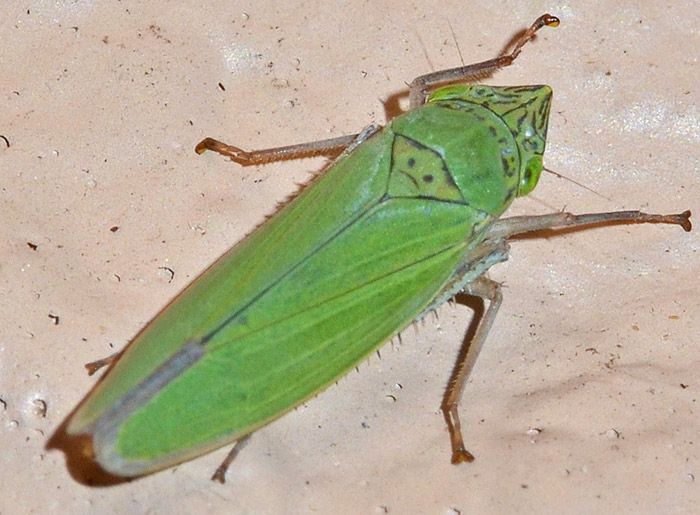 Draeculacephala inscripta (Waterlettuce Leafhopper). | Notice the little frowning face! This leafhopper species can be found near water, in marshes, and wetlands. Its nymphs and adults feed on Water Lettuce, Floating Primrose-willow, and Water-primrose.
bug guide (this photo): http://bugguide.net/node/view/1080374 | ||
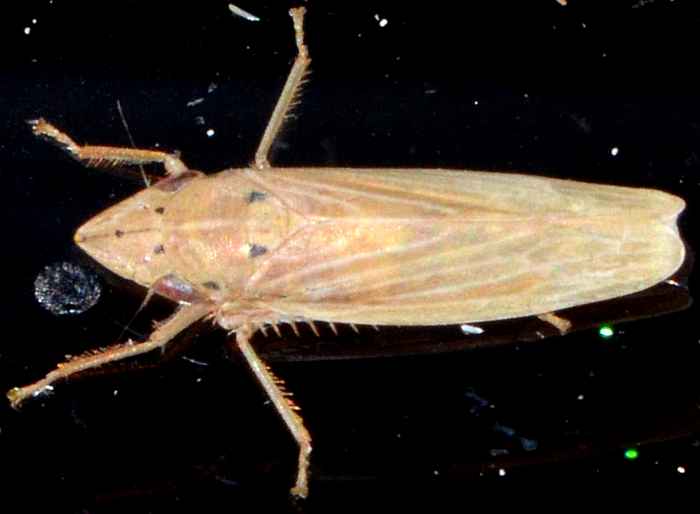 Draeculacephala septemguttata. | Another dogger: Draeculacephala septemguttata. This photo was identified down to the species by an expert on bugguide.net. bug guide (this photo): http://bugguide.net/node/view/636530 | ||
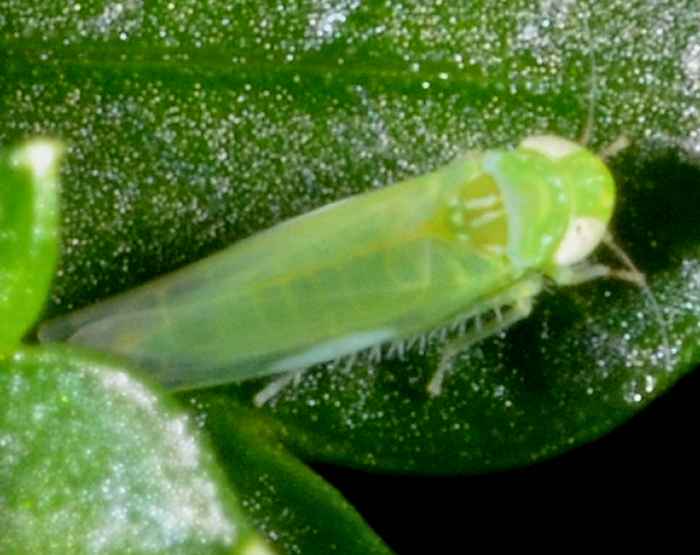 Empoasca sp.. | I found this tiny speck on Christmas Day. A couple of them were hanging out on my parsley which did extremely well this winter. There are numerous species of Empoasca in the US, which overwinter as adults on green plants. My best guess for this specimen is the Potato Leafhopper Empoasca fabae. bug guide (this photo): http://bugguide.net/node/view/603664 Tom Murray: http://www.pbase.com/tmurray74/leafhoppers_genus_empoasca | ||
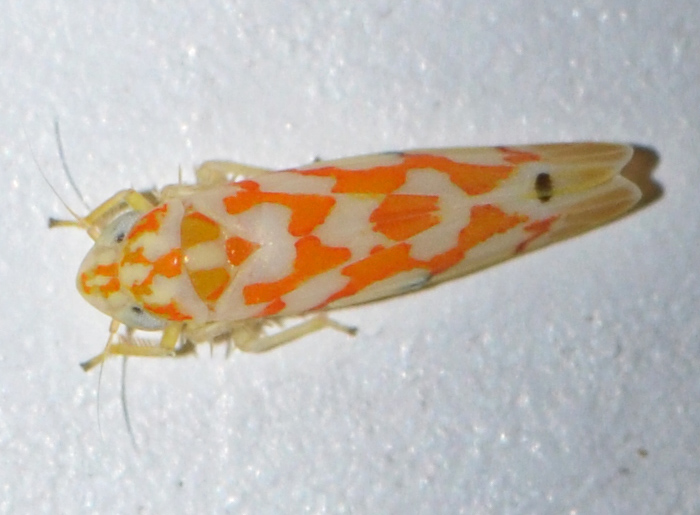 Eratoneura sp.. | Formerly a subgenus, or the "maculata" group, of Erythroneura, Eratoneura is a very similar looking genus. They mostly feed on oak, but E. maculata feeds on poison ivy.
bug guide (this photo): http://bugguide.net/node/view/1229705 | ||
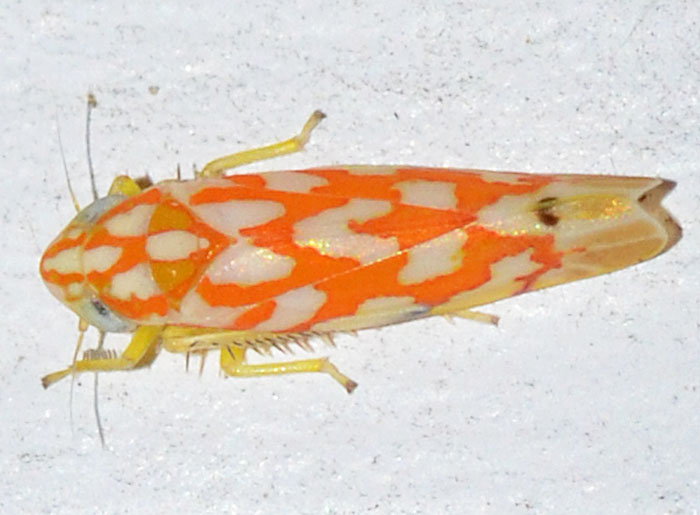 Eratoneura comoides. | To my naked eyes, this bug looked only like a little, orange line but I got immediately excited about the prospect of a cool, new leafhopper and amazing it is. I must admit that I am clueless about how to distinguish Erythroneura and Eratoneura (see below). bug guide (this photo): http://bugguide.net/node/view/1066950 | ||
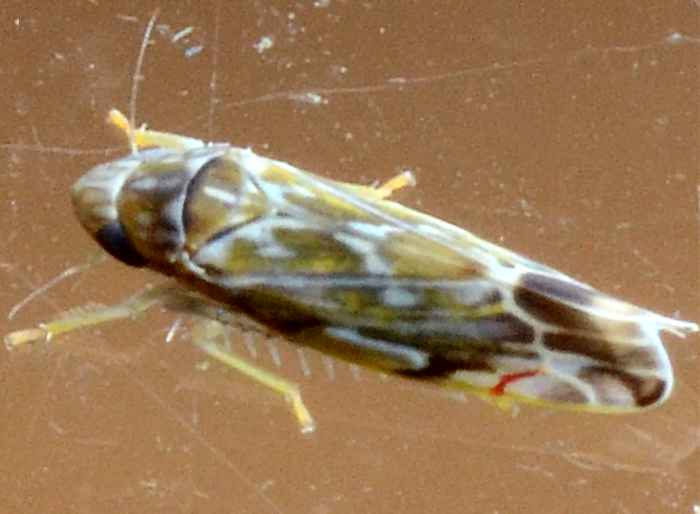 Erythroneura vulnerata. | The genus Erythroneura has ca. 70 species in North America. Like most of my leafhoppers, this specimen has been identified by an expert (see link). Based on the spare data on bugguide.net, this species (E. vulnerata) is more frequent in the eastern half of the country. bug guide (this photo): http://bugguide.net/node/view/656842 | ||
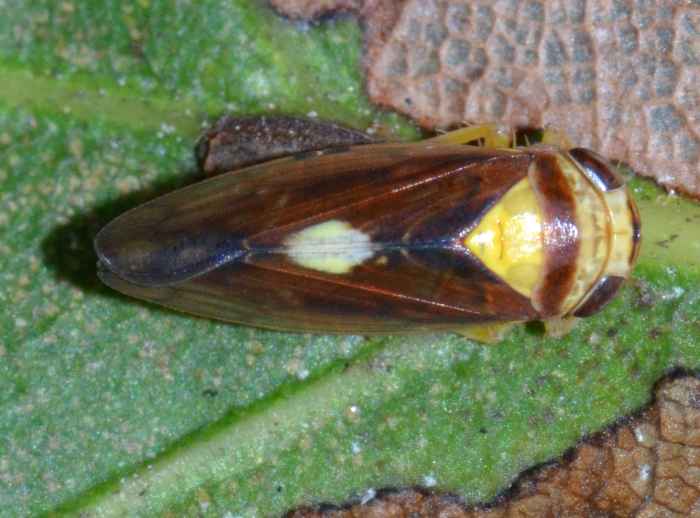 Eutettix pictus (Leafhopper (nonspecific)). | This beautiful leafhopper is Eutettix pictus. The genus has over 30 species in North America but currently only one is represented in the bug guide. A characteristic feature of this species is "a black bar across the front of the pronotum". The small photo on the right (shot 09/19/17) shows a different specimen.
bug guide (these photos): http://bugguide.net/node/view/567568 P. B. Lawson "The Cicadellidae of Kansas" Kansas Univ. Sci. Bull., Vol. XII(1), 1920, p. 180.: http://alturl.com/9comi | ||
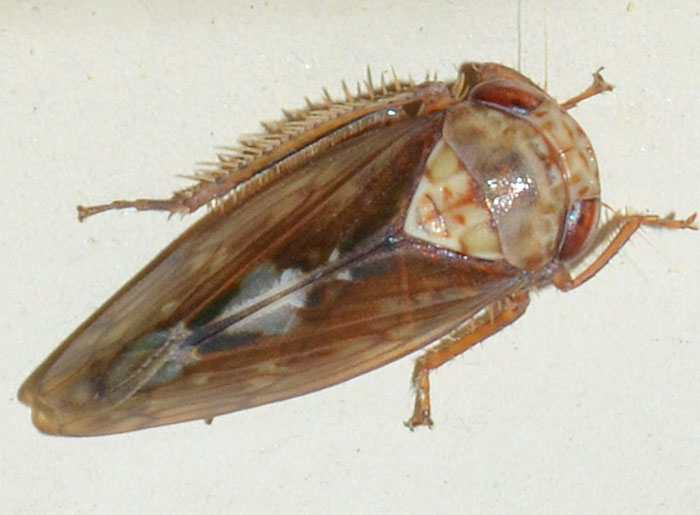 Eutettix luridus. | ... and a sister species which appears slightly wider than E. pictus. It lives on oak shrubs and is mainly found in the eastern states. The typical length is 6 mm. The small photo shows the same specimen.
bug guide (this photo): http://bugguide.net/node/view/1200611 | ||
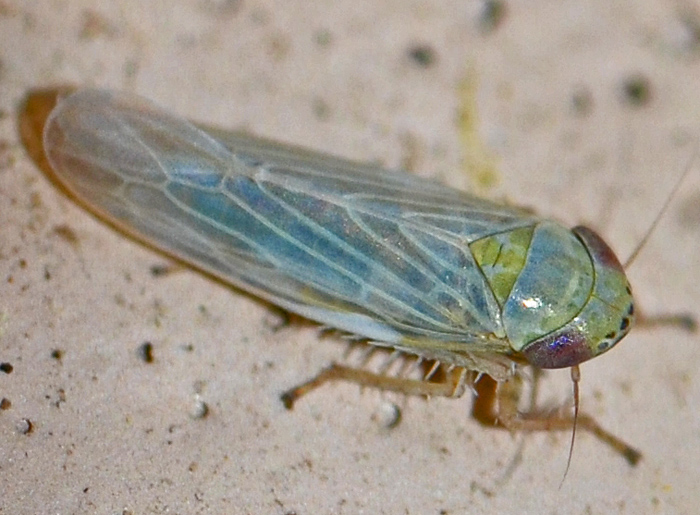 Graminella nigrifrons. | The second link notes "male chorusing behavior in Graminella nigrifrons. Like frogs, the males form alternating choruses, with one chorus emitting their vibrational calls while another group is silent. The leafhoppers responded readily to recorded calls of their species, easily falling into the rhythm of chorusing with a recording." The small photo shows a different specimen (05/16/16) that might be a different, similar species.
bug guide (this photo): https://bugguide.net/node/view/1224962 American Insects: http://www.americaninsects.net/h/graminella-nigrifrons.html | ||
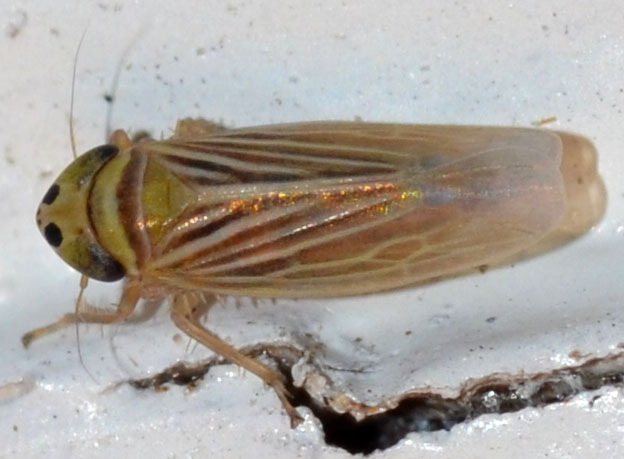 Graminella villica. | Clearly different from the Graminella entries above, this specimen is G. villica. I couldn't find any information on this little leafhopper but it was attracted to our porch light. bug guide (this photo): http://bugguide.net/node/view/1445461 | ||
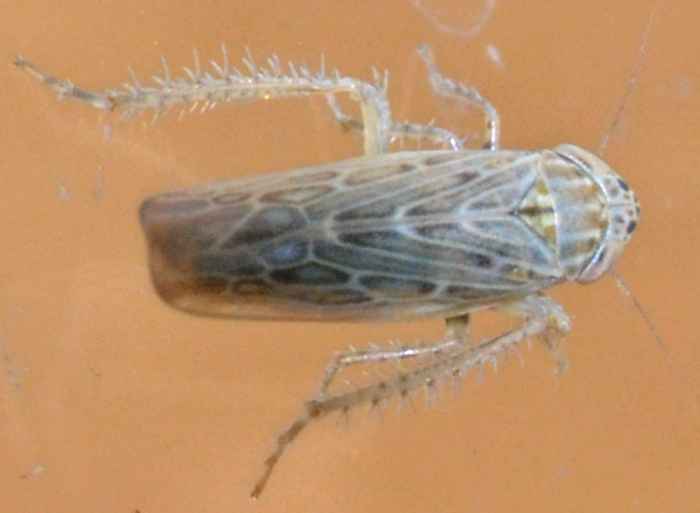 Graminella sonora. | Graminella sonora is a common leafhopper in the Southeastern US.
bug guide (these photos): http://bugguide.net/node/view/595623 | ||
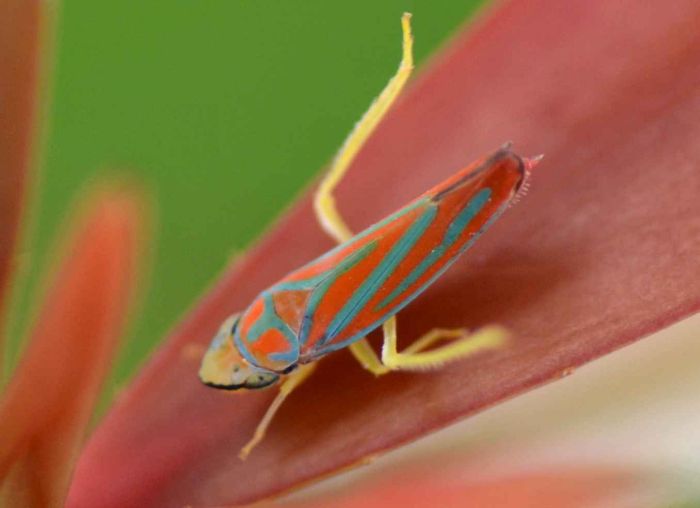 Graphocephala coccinea (Candy-Striped Leafhopper). | Leafhopper Graphocephala coccinea. Common names include candy-striped leafhopper, red-banded leafhopper, scarlet-and-green leafhopper, and red-and-blue leafhopper. These animals remind me of tropical fish and are just amazing. bug guide (this specimen, different photo): http://bugguide.net/node/view/547704 wikipedia: http://en.wikipedia.org/wiki/Graphocephala_coccinea | ||
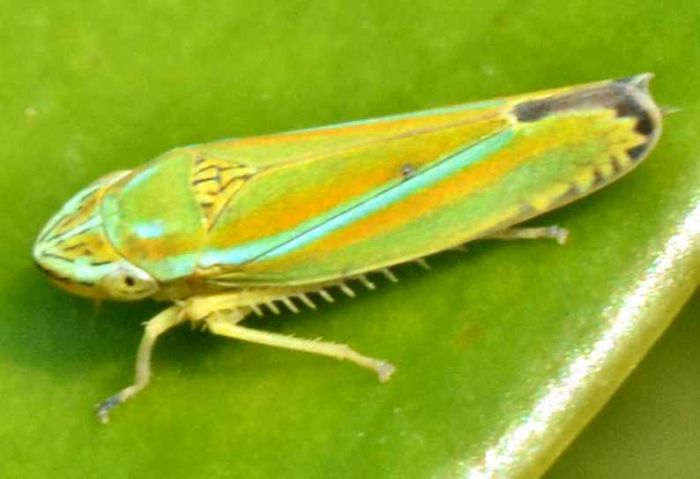 Graphocephala versuta (Versute Leafhopper). | A close relative of the former leafhopper: Graphocephala versuta. It is even smaller G. coccinea and reveals its amazing color patterns only in the magnified photograph. This species is more on the greenish side and has a black sawtooth markings at the apex.
bug guide: http://bugguide.net/node/view/549169 sharpshooters and leafhoppers of the world: http://naturalhistory.museumwales.ac.uk/sharpshooters/browserecord.php?-recid=612 | ||
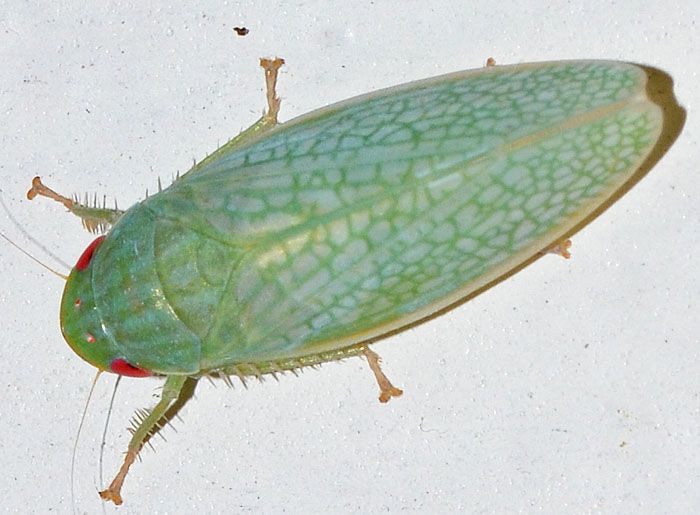 Gyponana sp.. | Gyponana is a subgenus. There are four species in the Southeast that have heavily reticulate wings like this: G. cana, G. procera, G. protenta and G. pruinosa. The small photo shows a different specimen (06/03/15, 9 pm).
bug guide (this photo): http://bugguide.net/node/view/1080842 bug guide (small photo): http://bugguide.net/node/view/1077840 | ||
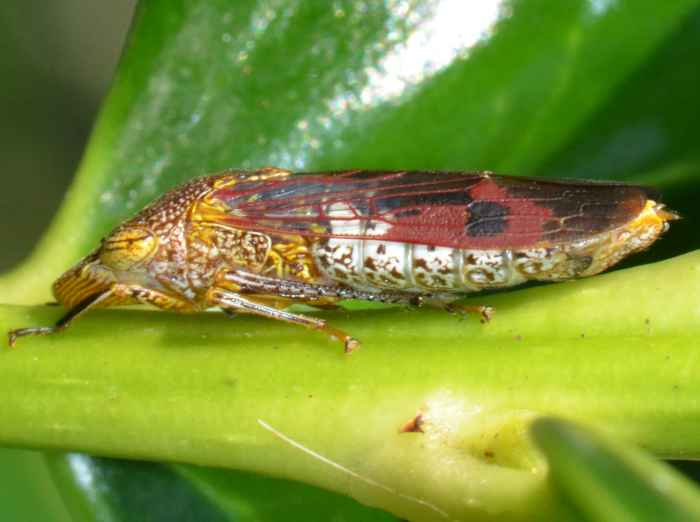 Homalodisca vitripennis (Glassy-Winged Sharpshooter). | A glassy-winged sharpshooter (Homalodisca vitripennis). It belongs to the leafhopper family and feeds on its host plant (here a small holly) by inserting a needle-like mouth part into the xylem. They extract trace nutrients and squirt out a stream of small droplets (hence the name "sharpshooter"). The small photos show different specimens on 06/28/11 (1 pm, left) and 08/27/11 (8 pm, right).
bug guide (the small photo): http://bugguide.net/node/view/536393 wikipedia: http://en.wikipedia.org/wiki/Glassy-winged_sharpshooter | ||
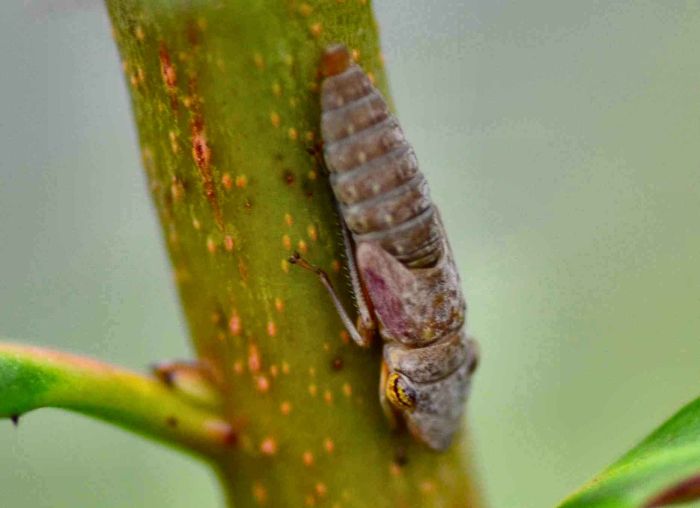 Homalodisca vitripennis (Glassy-Winged Sharpshooter) - imm. | A nymph of the glassy-winged sharpshooter (Homalodisca vitripennis). bug guide (this photo): http://bugguide.net/node/view/536393 wikipedia: http://en.wikipedia.org/wiki/Glassy-winged_sharpshooter | ||
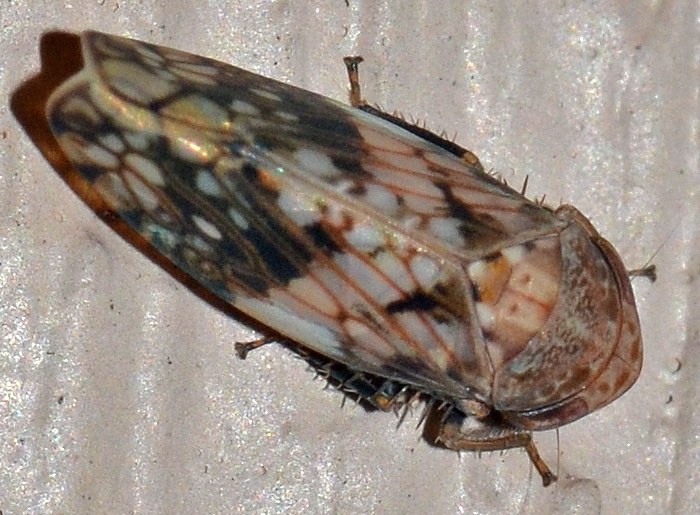 Menosoma cincta. | Menosoma cincta has a broad, white band across its wings and the Latin species name (derived from cinctus) refers to this girdle or belt. The leafhopper is found from Canada to Argentina. Of the total 12 or 13 species in the genus, only two are found in the US. bug guide (this photo): https://bugguide.net/node/view/1573781 | ||
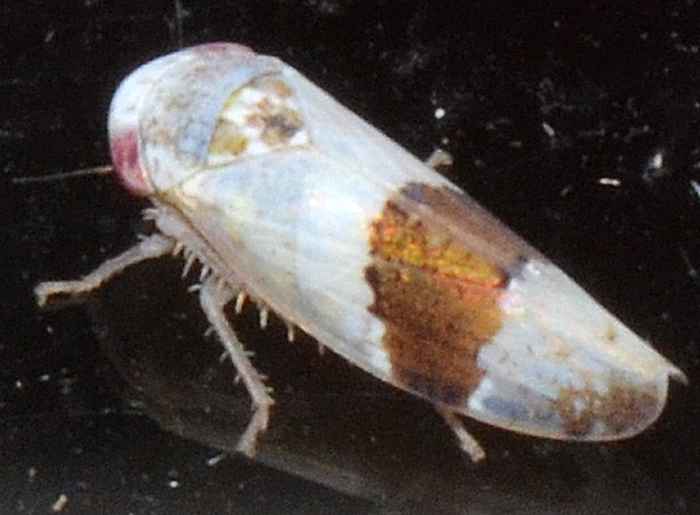 Norvellina seminuda. | Norvellina seminuda can transmit X-disease to stone fruits such as peaches. The species name "seminuda" means--well you can guess--half naked. There is one very similar looking species, N. novica which according to Dr. A. Hamilton, has shorter wings. He also states on the bugguide "The brown band (in N. seminuda) varies in exact shape, but is always at least as wide as the white space between it and the tip of the scutellum. In N. novica it is narrower than that space, in part due to the longer wings." bug guide (this photo): http://bugguide.net/node/view/646922 | ||
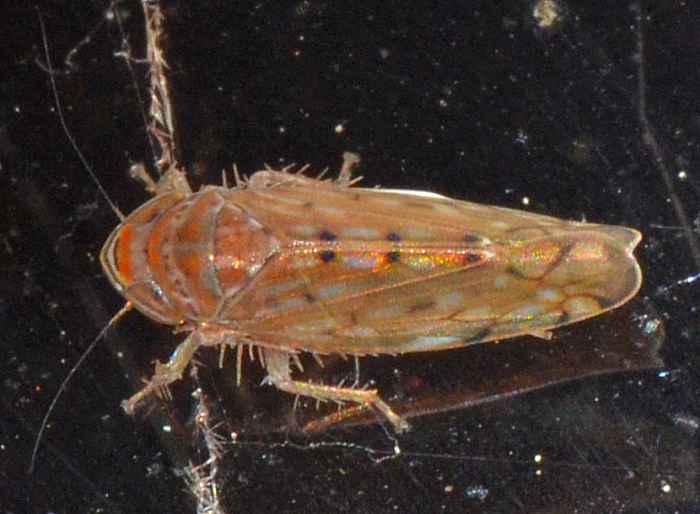 Osbornellus sp.. | The genus Osbornellus has 26 species in North America. It is part of the subfamily Deltocephalinae. bug guide (this photo): http://bugguide.net/node/view/631309 | ||
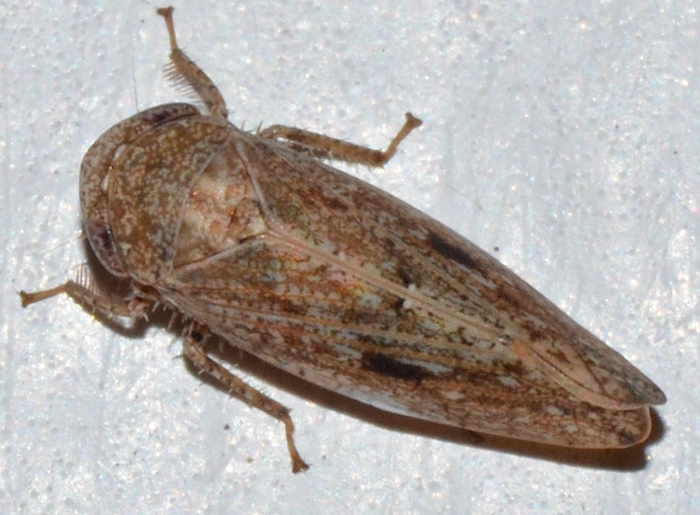 Paraphlepsius sp.. | The genus Paraphlepsius has many species in Florida and 69 species in North America. The hopper in the large photo is probably in the continuus species group. The small photos show a different specimen and were taken on 10/09/11 at 9 pm.
bug guide (large photo): http://bugguide.net/node/view/1217980 bug guide (small photos): http://bugguide.net/node/view/586594 | ||
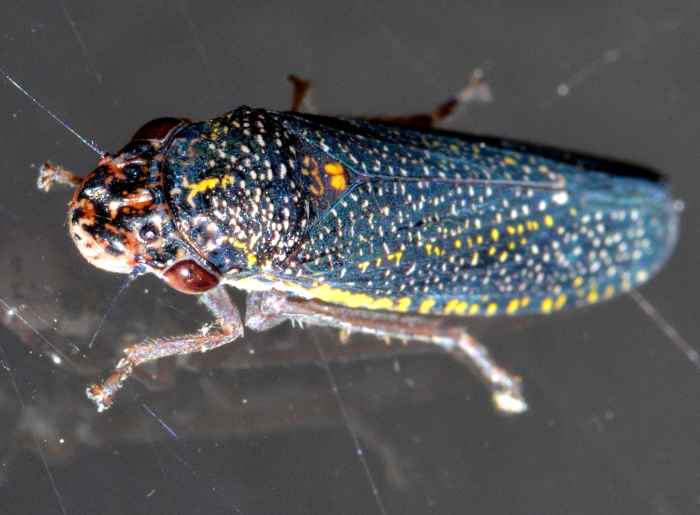 Paraulacizes irrorata (Speckled Sharpshooter). | This large fellow is a Speckled Sharpshooter (Paraulacizes irrorata). It is fairly common in the Eastern half of the country. Its nymphs are hairy and cool looking. bug guide (this photo): http://bugguide.net/node/view/652760http://bugguide.net/node/view/652760 | ||
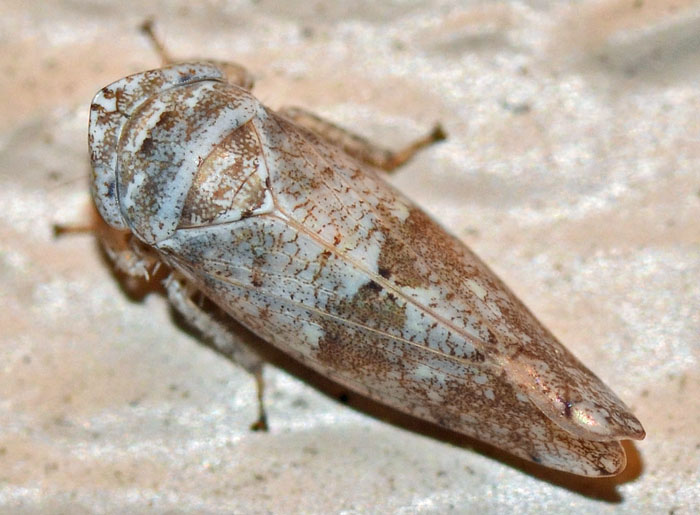 Pendarus punctiscriptus. | The genus has 14 species in two subgenera. bug guide (this photo): http://bugguide.net/node/view/1348170 American Insects: http://www.americaninsects.net/h/pendarus-punctiscriptus.html | ||
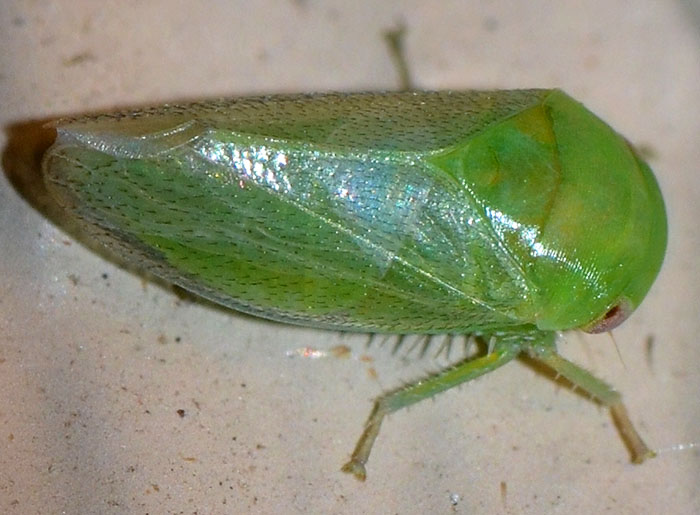 Penestragania robusta. | A stubby looking, bright green leafhopper with tiny black, dash-like marks and red eyes suggesting an earlier night of heavy partying. The species is not uncommon but mainly found in the South from Arizona to Florida. The small photo shows the same specimen that I found underneath our porch light.
bug guide (these photos): https://bugguide.net/node/view/1584911 | ||
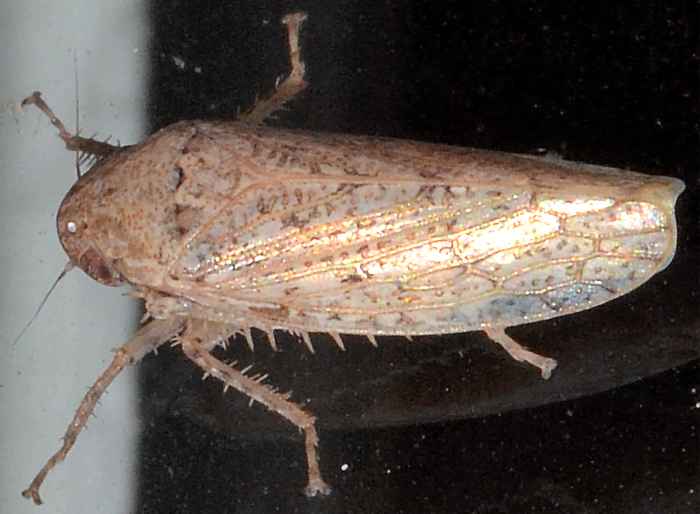 Ponana punctipennis. | Ponana punctipennis has spot-like markings all over, which distinguishes it from P. rubida. bug guide (this photo): http://bugguide.net/node/view/656416 | ||
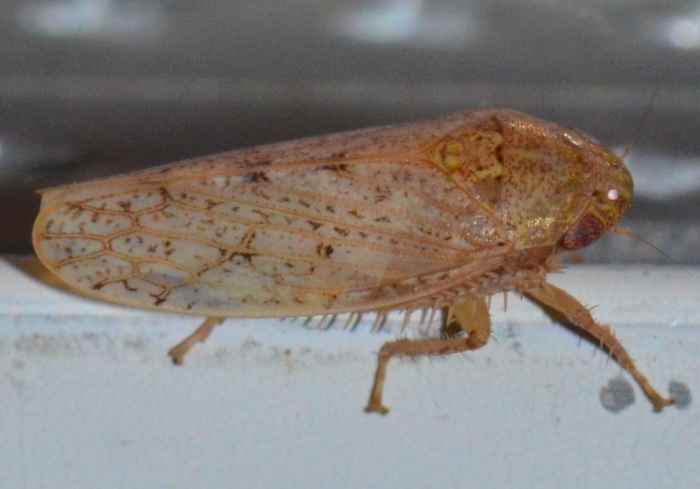 Ponana rubida (Leafhopper (nonspecific)). | This leafhopper is Ponana rubida. It came to the light of our living room window. The genus has 27 species in North America. The species P. rubida has very few markings.
bug guide: http://bugguide.net/node/view/572874 | ||
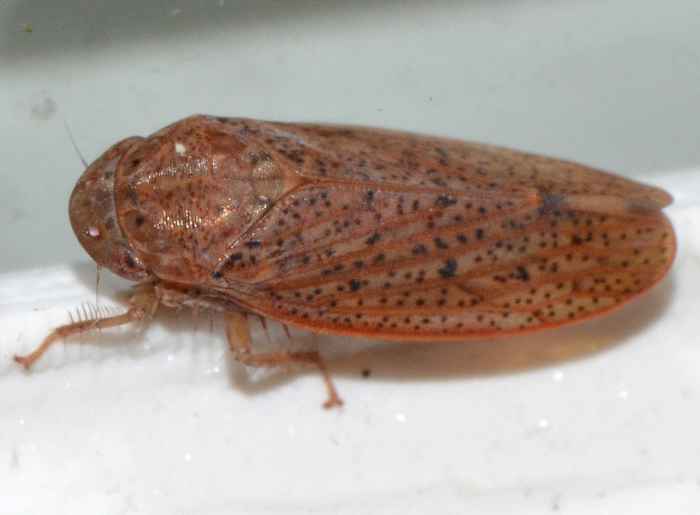 Ponana puncticollis. | Originally I thought this is another specimen of P. rubia but an expert identified it now as P. puncticollis. The word 'puncticollis' means 'spot-necked' and the typical length of these leafhoppers is 6-8 mm.
bug guide (this photo): https://bugguide.net/node/view/667659 | ||
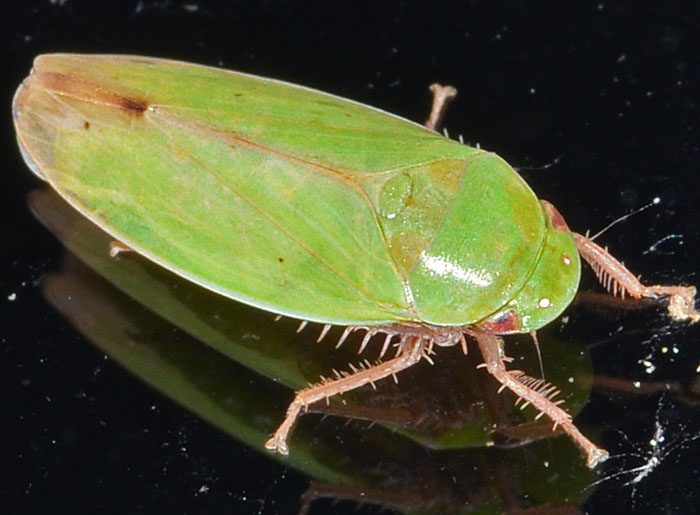 Ponana sp.. | This is a green specimen of the genus Ponana but really doesn't match up well with the reported species. bug guide (this photo): http://bugguide.net/node/view/990451 | ||
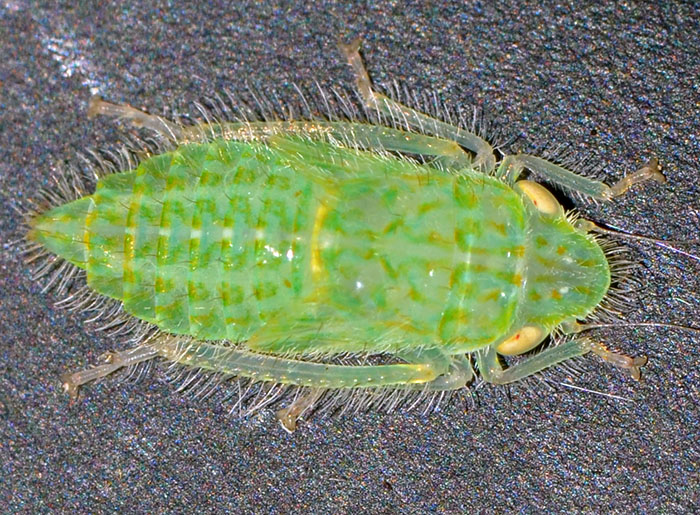 Rugosana querci - imm. | I found this rather large leafhopper nymph on my truck: a striking green spot on a black background. The adults have red eyes and their body color is a similar, patterned green. bug guide (this photo): http://bugguide.net/node/view/1363237 | ||
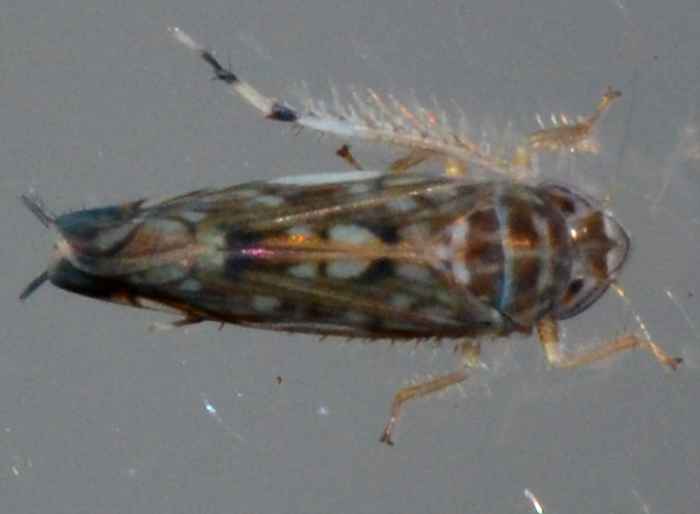 Scaphoideus sp.. | The genus Scaphoideus has 54 species in North America. They transmit the phytoplasma that causes elm yellows. An expert (see link) pointed out that "the toothlike mark on the middle of the head is characteristic" for this genus. The small photo below was taken on 06/21/12.
bug guide (large photo): http://bugguide.net/node/view/635314 bug guide (small photo): http://bugguide.net/node/view/661486 | ||
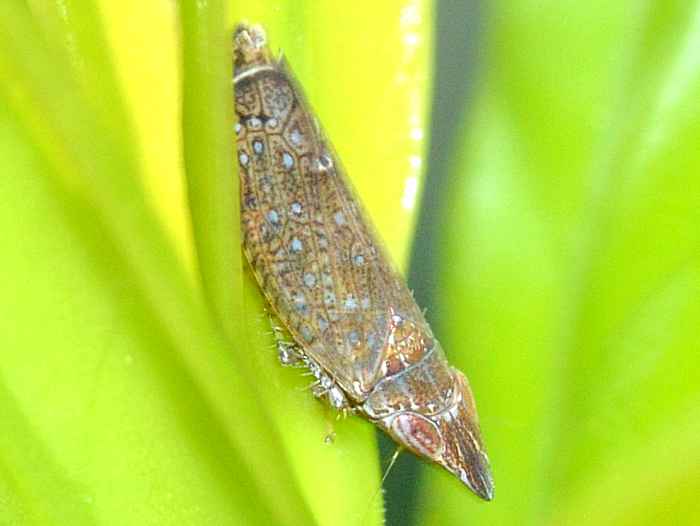 Scaphytopius latus (Leafhopper (nonspecific)). | This leafhopper looks like a sharpshooter (to me) but belongs to a different subfamily (Deltocephalinae rather than Cicadellinae). It is Scaphytopius latus which is a probable vector of X-disease in peach trees. The genus has at least 17 species in Florida. bug guide (this photo): http://bugguide.net/node/view/568675 Musgrave, Entomol. Circ. 204, July 1979.: http://www.freshfromflorida.com/pi/enpp/ento/entcirc/ent204.pdf | ||
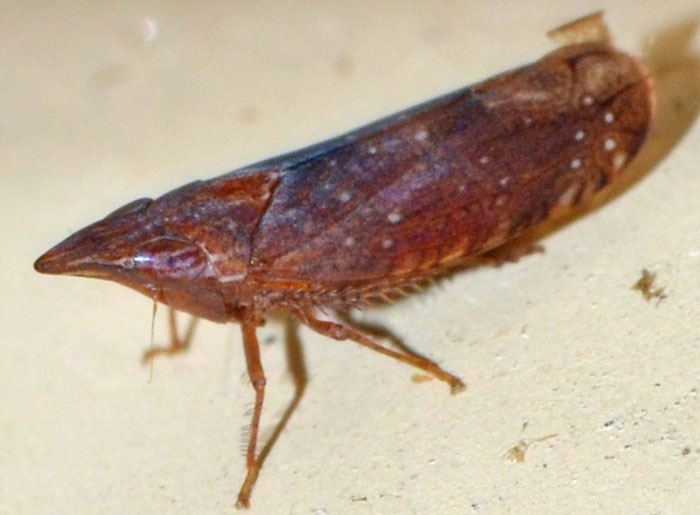 Scaphytopius rubellus. | I'm sorry, Scaphytopius rubellus, but you do not look very trustworthy.
These leafhoppers are about 4-5 mm long. Their preferred food source is sweetgum (Liquidambar styraciflua). bug guide (this photo): http://bugguide.net/node/view/1054356 | ||
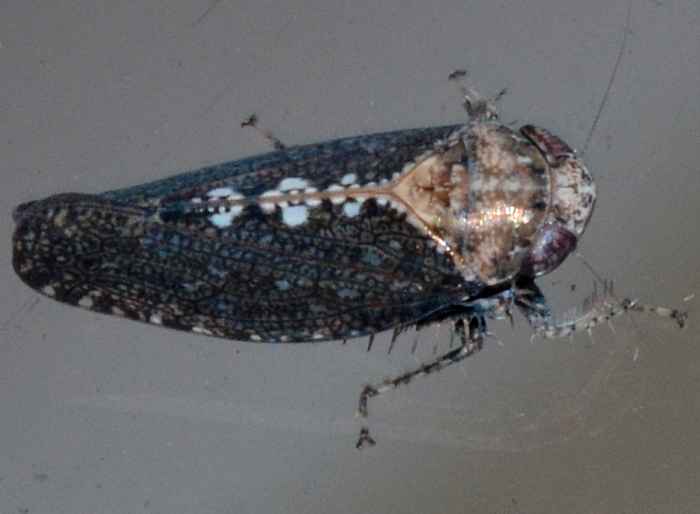 Texananus sp.. | This leafhopper is Texanus subgenus Excultanus. The genus Texanus has about 70 species. A characteristic feature are the three white spots down the middle of the wing. Some references treat the subgenus Excultanus as a separate genus.
bug guide (these photos): http://bugguide.net/node/view/656406 | ||
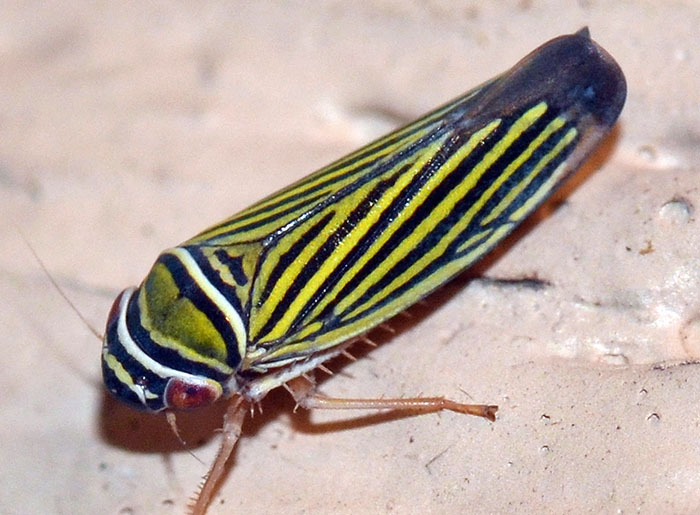 Tylozygus bifidus. | This pretty leafhopper is Tylozygus bifidus. The species can be found in the Eastern half of the US. The dark stripe pattern is distinctive but the color varies from blueish gray to yellow. The small photos were taken on 07/13/12 around 11 pm.
bug guide (this photo): https://bugguide.net/node/view/1586107 bug guide (small photos): http://bugguide.net/node/view/673278 | ||
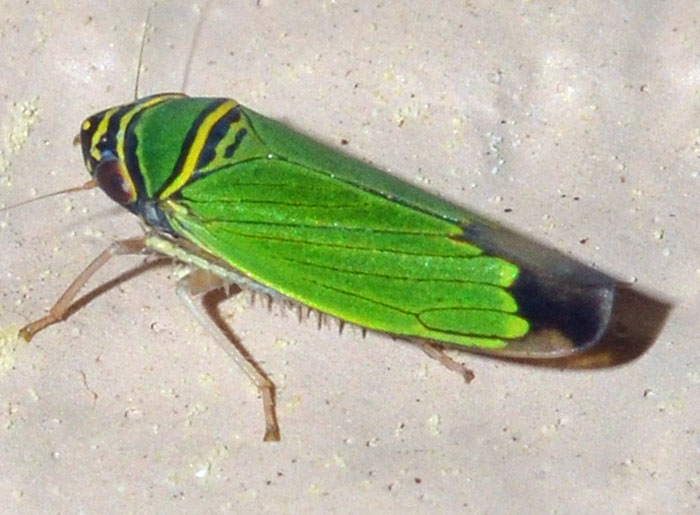 Tylozygus geometricus. | Another beautiful leafhoppper. The bold yellow, transverse bands seem to be characteristic. The genus has three species in our area. So one to go ... bug guide (this photo): http://bugguide.net/node/view/1053756 | ||
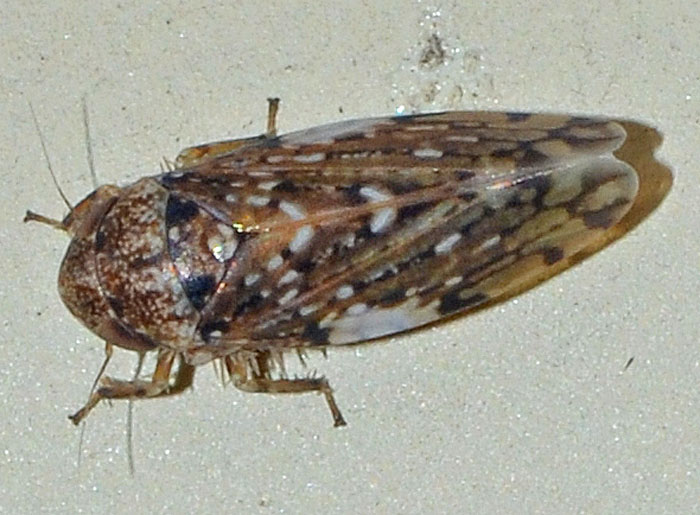 Xestocephalus sp.. | Wow, Xestocephalus has 120 species. This could be X. tesselatus but that's a bit of a guess. Bugguide.net mentions that this leafhopper could be "myrmecophilous" meaning (as I just learned) that the species plays a certain role in an associated host ant colony. bug guide (this photo): http://bugguide.net/node/view/1078460 Rakitov, J. New York Entomol. Soc. 108, 171 (2000): http://tinyurl.com/XESTOCEPHALUS | ||
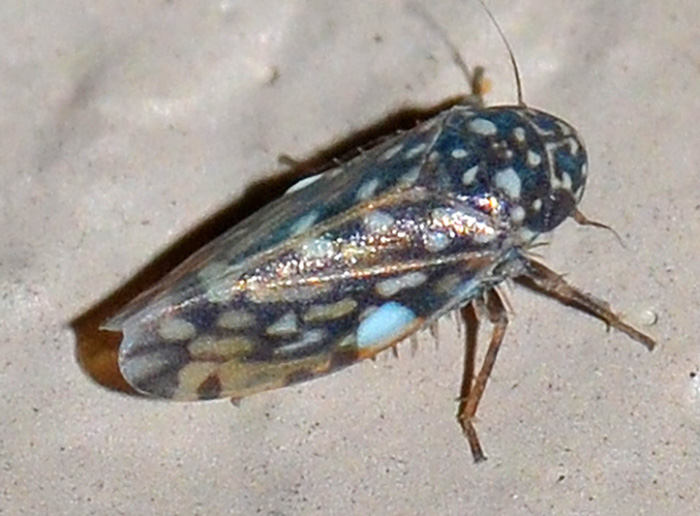 Xestocephalus superbus. | This tiny leafhopper is an "ant-guest" living as an immature in the tunnels of ant nests, where it presumably feeds on the roots of plants. Adults fly around a lot looking for other ant nests. They are quite common in North America but perhaps not so much in Florida. When I posted this photo on bugguide.net, it was the first photo of this species for Florida. I am also intrigued by the rectangular bracket-like patterns on the leafhopper's head.
bug guide (this photo): https://bugguide.net/node/view/1599266 |

